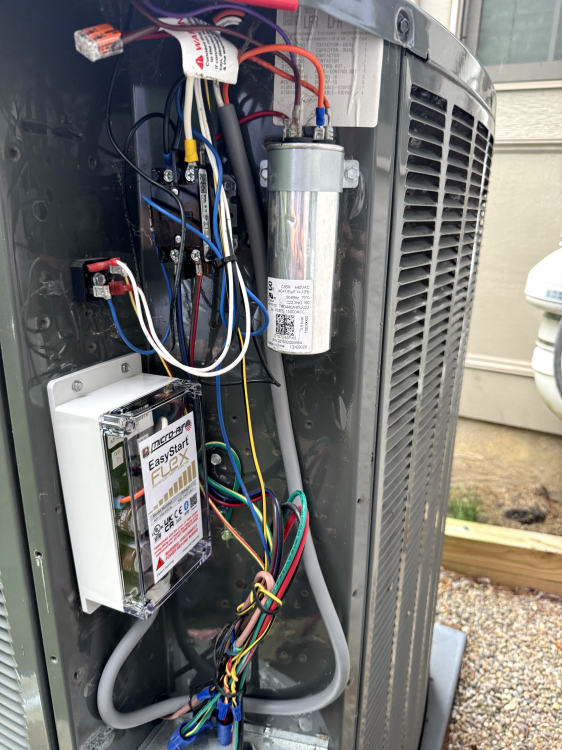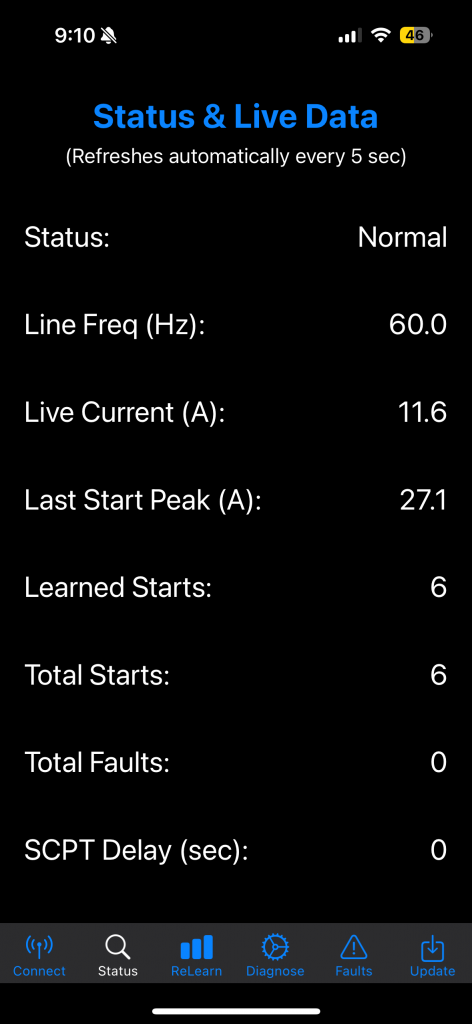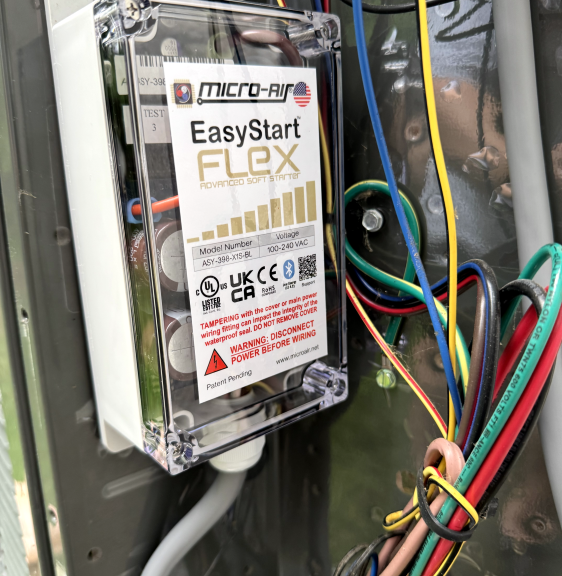Imagine this: you’re sipping your evening beverage or having dinner with family, the A/C kicks on…and suddenly every LED bulb in the house pulses like a disco strobe. What’s going on?
That’s exactly what happened after we installed our “Big Boy” – a Trane XL17 5‑ton AC unit outside of our house. One whiff of summer heat, and our lights went bump each and every time it kicked on.
Spoiler: it wasn’t haunted wiring—just physics.
Why LEDs Flicker: The Locked‑Rotor Amperage Shock
I dove into the specs and discovered our compressor’s Locked‑Rotor Amperage (LRA) was 152.9 amps—that’s the maximum surge (inrush current) it could require to get spinning under the default configuration when the motor is cold starting from rest.
- Your home’s main breaker: 200 amps
- Maximum Inrush demand: at 152.9 Amps, ~75% of that
A 75% spike—even if it lasts only milliseconds—can dip the line enough to make common LED bulbs perceptibly shutter. Incandescent lighting likely wouldn’t be as noticable… but this is 2025 and incandescent lights are a thing of the past. Thermal breakers (like the ones in your breaker box) shrug the spike off because the demand is short lived (no trip), but your LED lights definitely notice… and so do you.
Beyond Flicker: Real‑World Headaches
That huge startup spike doesn’t just bug your eyes. It can:
- Overload backup generators if your utility power is out (even 23 kW or 26kW units can choke, especially if they are already carrying a large load)
- Strain solar inverters when you go off‑grid, similar to above.
- Accelerate compressor wear, since the old‐school capacitor start slams full voltage on a cold motor
I wanted a kinder, gentler start for my expensive hardware—and a smoother ride when our future whole‑house generator finally arrives.
Enter the EasyStart Flex
After some Googling, I found the EasyStart Flex (Amazon) by MicroAir—a tried‑and‑true solution in the marine and RV world where generators are common and power is limited that is now available for home compressors to solve similar problems.
Why the Flex?
- Smart electronic soft‑start: reduces inrush by ramping voltage (what is soft start?)
- Learning algorithm: adapts to your specific motor over 5 cycles
- App monitoring: watch each start in real time on Android or iOS
A 30‑Minute DIY Upgrade
Wiring is so simple: just four wires on the Easy Start system. Micro-Air has many installation guides on their website, and a FAQ that I found helpful. If all else fails – they have a support ticketing system and were super responsive to my questions. As an avid DIYer that knows just enough to be dangerous sometimes, I appreciated how quickly they responded with concise and useful information. (Note: The following guidance should apply to most systems, but I am specifically talking about my Trane XR17. Make sure to check the guides linked above for your specific system).
- TURN OFF ALL AC POWER TO THE UNIT – this can be usually be done by removing the disconnect on your external unit. Optionally, you can flip the breaker inside your main panel associated with your outside unit.
- Verify the Capacitor is not energized. This can be done by using an INSULATED screwdriver to short across the Common (C) and Fan (F) terminals, and then again across the Common (C) and Compressor (HERM) terminals.
- Orange Wire → HERM terminal on capacitor
- Black Wire → Contactor common
- White Wire → Replaces red compressor wire on contactor
- Brown Wire → Splice into the red compressor wire replaced in step 3
- Mount the Unit → Mount the Easy Start somewhere inside or outside of your unit. The box is waterproof, you only need to ensure that the pigtail coming out of the box is facing downward to allow water to drip away rather than collecting on the gasket. On larger units like mine, I simply mounted it inside the electrical panel on the box using sheet metal screws – just make sure that you have enough clearance to not impact any components on the other side of your mounting point.

Once hooked up, you flip the AC power back on and trigger five training cycles:
- Cycles 1–4: call Stage 1 only
- Cycle 5: call Stage 2 right away (If you have a single stage compressor, you just perform 5 cycles since you don’t have a Stage 2)
(Tip: many contractors leave your control board set to auto‑ramp from Stage 1 to Stage 2 on a timer and ignore staging calls from the Y1 and Y2 wires on thermostats —if yours ignores Y2 calls, you’ll need to either hold Stage 1 longer or, ideally, change the config on your furnace control board and swap in a “smart” thermostat that truly drives Y2. Then, you can set your thermostat to call for Y2 automatically when there is a 2 degree delta in your setpoint versus ambient. So to force stage 1, if your ambient is 74, you just set it to 73 to force stage 1 and 72 or less to force stage 2.)
The Big Reveal
After five learning starts, here’s what happened:
- Start #1: inrush fell from a maximum of 152.9 A and an observed 132 A to 47.1 A
- Start #2: down to 37 A
- After #5: stabilized at 27.9 A
Then…lights stayed rock‑steady. And bonus: the whole startup process is noticeably quieter, since the Easy Start is designed to spin up the fan first, then the compressor — an intelligent design that further limits startup current draw.

So, Why Don’t All HVAC Units Ship With This?
My opinion – Two cold, hard truths:
- Cost. An Easy Start adds ~$400 to your HVAC compressor cost (of course, less at “cost” – but it is not an insignificant number). This means you are either cutting into OEM margins or increasing the cost to the consumer.
- Planned obsolescence. Traditional capacitor‑start compressors already last 10–15 years; a soft‑start could stretch that—but why reduce future service calls? Why extend the already long life of a HVAC unit – after all, future problems = future customers.
Me? I’d gladly pay $500–1,000 more for a longer‑lasting, stress‑free compressor. But mass‑market buyers chase the cheapest quote, and manufacturers follow. On top of that, manufacturers need to sell new units.
My Takeaway & Your Next Steps
If you:
- “Love” your HVAC investment and want it to last
- Plan to run on a backup generator or a solar inverter
- Hate flickering lights
…an Easy Start is a game‑changer. I’ll circle back in a few months with a long‑term update—stay tuned!

